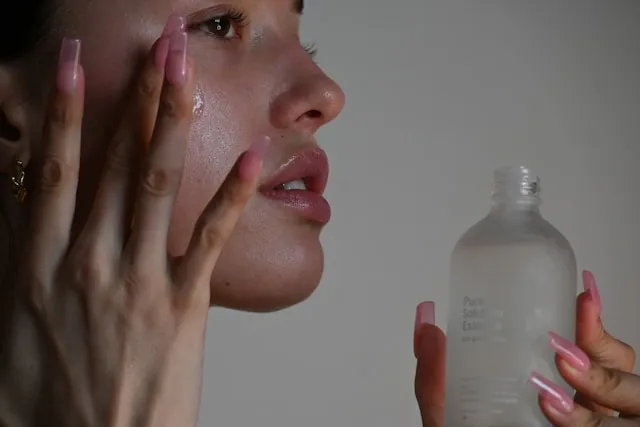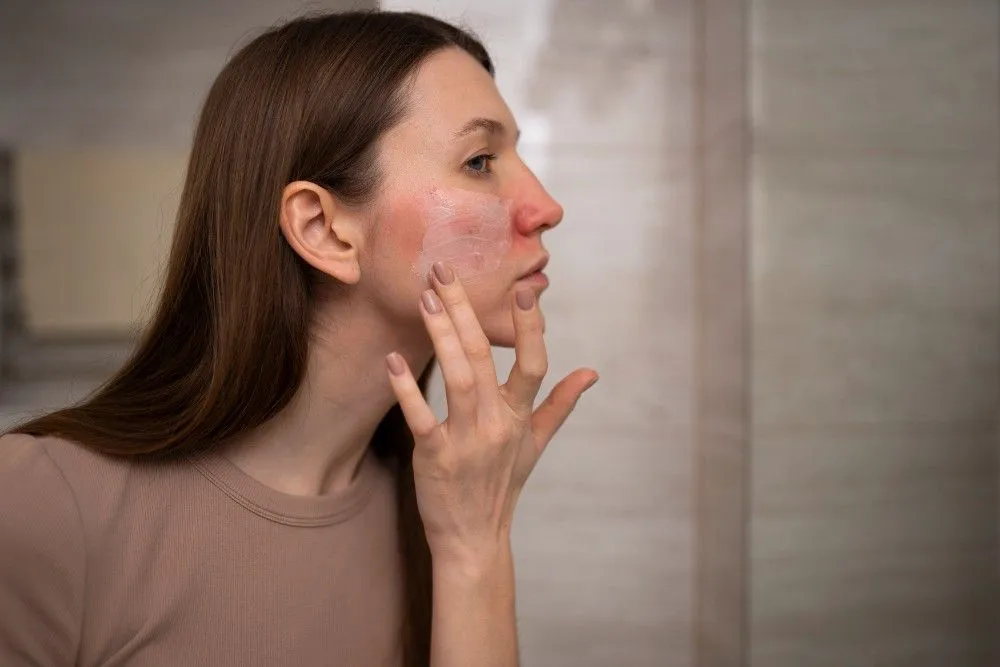Fordyce spot treatment are common skin conditions presenting as enlarged sebaceous glands that produce oil. They are also known as Fordyce Granules or Fordyce Glands. These spots are common as a skin variant and can be found in up to 70% to 80% of adults.
Typically, they are present from birth. However, they may become more prominent and visible post-puberty as there is increased oil production and hormonal influences.
Fordyce spots are often characterized as small spots that look like whitish-yellow bumps. They are most commonly found on areas of the skin that do not have any hair follicles. The most common locations for Fordyce spots would be the inside lining of the cheeks and the vermillion border of the lips, where the lips meet the facial skin.
Also, Read 12 Reasons Why Your Skin Itches.
 Fordyce spots are small, harmless, raised bumps that can appear on the skin, especially on the lips or genital area. While Fordyce spots do not require treatment for medical reasons, some people may choose to pursue treatment for cosmetic reasons or if they experience discomfort. Here are the top 10 treatments that may be considered for Fordyce spots:
Also, Read The Best Acne-Fighting Skin Care Routines
Fordyce spots are small, harmless, raised bumps that can appear on the skin, especially on the lips or genital area. While Fordyce spots do not require treatment for medical reasons, some people may choose to pursue treatment for cosmetic reasons or if they experience discomfort. Here are the top 10 treatments that may be considered for Fordyce spots:
Also, Read The Best Acne-Fighting Skin Care Routines
How are Fordyce Spots Treated?
It is generally unnecessary to treat Fordyce spots, as they are not harmful or malignant. Even so, some individuals may opt for treatment options due to their cosmetic concerns or to address self-image concerns associated with the spots. However, it is crucial to note that it is recommended that you consult a healthcare professional or a dermatologist to discuss treatment options that are relevant and best for you. You must avoid picking or squeezing your Fordyce spots as that may result in irritation and infections, and the situation may become way more complicated. Even without any medical intervention, Fordyce spots tend to go away naturally. Suppose you want to opt for any Fordyce spot treatment. In that case, it is best to consult with a dermatologist to discuss the potential risks and benefits of a relevant procedure and also get a proper evaluation of your condition.Listing Top 10 Treatments for Fordyce Spots -
 Fordyce spots are small, harmless, raised bumps that can appear on the skin, especially on the lips or genital area. While Fordyce spots do not require treatment for medical reasons, some people may choose to pursue treatment for cosmetic reasons or if they experience discomfort. Here are the top 10 treatments that may be considered for Fordyce spots:
Also, Read The Best Acne-Fighting Skin Care Routines
Fordyce spots are small, harmless, raised bumps that can appear on the skin, especially on the lips or genital area. While Fordyce spots do not require treatment for medical reasons, some people may choose to pursue treatment for cosmetic reasons or if they experience discomfort. Here are the top 10 treatments that may be considered for Fordyce spots:
Also, Read The Best Acne-Fighting Skin Care Routines
#1 Topical Tretinoin (Retin-A)
Fordyce spots can be treated using topical tretinoin. It is also commonly known as Retin-A. Retin-A, or tropical tretinoin, a vitamin A derivative, is commonly used in dermatology for various skin conditions, including acne. Applying tretinoin topical helps promote the shedding of dead skin cells and simultaneously stimulates the growth of fresh new skin cells.#2 Oral Isotretinoin
Primarily, oral isotretinoin is used for the treatment of severe acne. While it is not popularly prescribed for Fordyce spots, a few dermatologists may consider it an off-label treatment option for extensive cases of Fordyce spots. Oral isotretinoin is only used as a treatment option in case of Fordyce spots if other treatment options have been ineffective or if the spots are causing a significant amount of stress or discomfort. The mechanism of action for oral isotretinoin is not and has yet to bed, and it is important to note that the effect may vary between individuals.#3 Cryotherapy
For Cryotherapy, your dermatologist applies a cold substance, such as liquid nitrogen or argon gas, to the Fordyce spots. The extreme cold temperatures that the skin is subjected to cause the target cells to freeze, which results in their disintegration or death. Over time, the dead tissue will slough off and be replaced by new tissue. Cryotherapy can be very effective as a treatment for Fordyce spots, but it may not be able to eradicate all the spots at once. It is the kind of treatment done in sessions, and multiple treatment sessions are needed to complete Cryotherapy. Additionally, it is important to take note of the potential risks, side effects, skin discoloration, scarring, or even blistering. Also, Read 10 Best skin-whitening creams#4 Topical Trichloroacetic Acid (TCA)
Another treatment option for Fordyce spots can be TCA (Topical Trichloroacetic Acid). It can shrink Fordyce spots upon direct application to the skin. When applied to the skin, TCA destructs the affected tissue by chemical burning or cauterization. This leads to a reduction in the size of the spots. TCA is not usually used as a sole treatment. It is used alongside other ongoing treatments, such as laser therapy.#5 Electrofulguration (electro hyfrecation) -
This is a treatment method that can be effectively used for Fordyce spots. The treatment involves effective burning of the Fordyce spots using a small, handheld device that delivers a low-level electric current to the required areas. A local anesthetic may be applied to the target area throughout the treatment to minimize discomfort. A professional carries out this procedure using an electrofulguration device to precisely target the Fordyce spots.#6 Micro-punch surgery -
Fordyce spots can also be treated using a surgical technique known as micro punch surgery. The procedure involves a small pen-like device to punch the skin and remove the affected tissue. This procedure is carried out under local anesthesia to minimize the patient's discomfort. The micro punch procedure is one of the rare procedures that allow the removal of Fordyce spots without causing significant scarring. This procedure has also been significantly supported by research. Also, Read 10 Best Moisturizers for Oily Skin in India#7 Laser Treatments -
Another option for Fordyce spot treatment is laser treatment. There are two commonly used laser treatments for Fordyce spots. They are CO2 laser and pulsed dye laser. The CO2 Laser treatment uses a concentrated beam of light of a specific wavelength with enough intensity to target and remove the tissue that has been affected. This treatment can undoubtedly treat Fordyce spots, but it has a higher risk of scarring than pulse dye laser. Pulse dye laser uses a wavelength of light different from the one used in CO2 laser treatment. It targets the Fordyce spots and treats them. It also has a lower risk of scarring, comparatively.#8 Apple Cider Vinegar -
Apple cider vinegar has general antibacterial properties. It is unlikely to specifically target or eliminate Fordyce spots. However, it is an open option if you want to try natural remedies. Self-treating conditions which can be treated with home remedies may not always work out for an individual and may also have adverse effects, but every treatment has a downside. However, before you treat yourself with such home remedies, it is always advised to consult with your skin care professional or dermatologist.#9 Coconut Oil -
Coconut oil is a common natural oil with moisturizing properties and is known to be beneficial for skin hydration. While coconut oil may help with skin hydration and provide some benefits, it is not likely that the treatment of Fordyce spots using Coconut Oil will be much more effective. However, it is crucial to remember that how an individual responds to any treatment is unique and may be different for you than for someone else. Also, Read How to Use Essential Oils for Ear Infection?#10 Jojoba Oil and Argan oil -
Popular natural oils that are often used in skincare are Jojoba and Argan Oil. They are popularly known for their moisturizing properties and positive effects on skin health. However, their effect on Fordyce spots requires further concrete research. Individual responses to skin care are unique, and it is highly advised that you discuss this with your dermatologist before going ahead with any natural or herbal treatment.Conclude -
Fordyce spots, though harmless, can cause cosmetic concerns or discomfort. While no medical treatment is necessary, various options are available to reduce their appearance or alleviate symptoms. These include topical retinoids, electrodesiccation, Cryotherapy, CO2 laser therapy, pulsed dye laser, chemical peels, surgical excision, photodynamic therapy, oral isotretinoin, and micro-needling. Consulting a dermatologist or healthcare professional is crucial to determine the best treatment based on individual circumstances. Fordyce spot treatment outcomes may vary, and multiple sessions or combinations of treatments may be required. The decision to pursue treatment should consider potential benefits, risks, and personal factors.
Reviewed by







